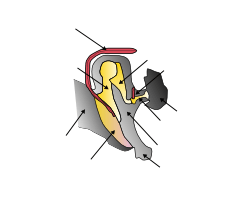Malleus
| Malleus | |
|---|---|

Malleus
Bones and muscles in the tympanic cavity in the middle ear | |
 Left malleus. A. From behind. B. From within. | |
 The right membrana tympani with the hammer and the chorda tympani, viewed from within, from behind, and from above. (Malleus visible at center.) | |
| Details | |
| Precursor | 1st branchial arch[1] |
| Identifiers | |
| Latin | Malleus |
| MeSH | A09.246.397.247.524 |
| TA | A15.3.02.043 |
| FMA | 52753 |
 |
| This article is one of a series documenting the anatomy of the |
| Human ear |
|---|
|
The malleus /ˈmæliəs/ or hammer is a hammer-shaped small bone or ossicle of the middle ear which connects with the incus and is attached to the inner surface of the eardrum. The word is Latin for hammer or mallet. It transmits the sound vibrations from the eardrum to the incus.
Structure
The malleus is a bone situated in the middle ear. It is the first of the three ossicles, and attached to the tympanic membrane. The head of the malleus is the large protruding section, which attaches to the incus. The head connects to the neck of malleus, and the bone continues as the handle of malleus, which connects to the tympanic membrane. Between the neck and handle of the malleus, lateral and anterior processes emerge from the bone.[2]
The malleus is unique to mammals, and evolved from a lower jaw bone in basal amniotes called the articular, which still forms part of the jaw joint in reptiles and birds.[3]
Development
Embryologically it is derived from the first pharyngeal arch along with the rest of the bones of mastication, such as the maxilla and mandible.
Function
The malleus is one of three ossicles in the middle ear which transmit sound from the tympanic membrane (ear drum) to the inner ear. The malleus receives vibrations from the tympanic membrane and transmits this to the incus.[2]
History
Several sources attribute the discovery of the malleus to the anatomist and philosopher Alessandro Achillini.[4][5] The first brief written description of the malleus was by Berengario da Carpi in his Commentaria super anatomia Mundini (1521).[6] Niccolo Massa's Liber introductorius anatomiae[7] described the malleus in slightly more detail and likened both it and the incus to little hammers terming them malleoli.[8]
Additional images
|
See also
- Bone terminology
- Evolution of mammalian auditory ossicles
- Ligaments of malleus
- Terms for anatomical location
References
- ↑ hednk-023—Embryo Images at University of North Carolina
- 1 2 Mitchell, Richard L. Drake, Wayne Vogl, Adam W. M. (2005). Gray's anatomy for students. Philadelphia, Pa.: Elsevier. p. 862. ISBN 978-0-8089-2306-0.
- ↑ Ramachandran, V. S.; Blakeslee, S. (1999). Phantoms in the Brain. Quill. p. 210. ISBN 9780688172176.
- ↑ Alidosi, GNP. I dottori Bolognesi di teologia, filosofia, medicina e d'arti liberali dall'anno 1000 per tutto marzo del 1623, Tebaldini, N., Bologna, 1623. http://gallica.bnf.fr/ark:/12148/bpt6k51029z/f35.image#
- ↑ Lind, L. R. Studies in pre-Vesalian anatomy. Biography, translations, documents, American Philosophical Society, Philadelphia, 1975. p.40
- ↑ Jacopo Berengario da Carpi,Commentaria super anatomia Mundini, Bologna, 1521. https://archive.org/details/ita-bnc-mag-00001056-001
- ↑ Niccolo Massa, Liber introductorius anatomiae, Venice, 1536. p.166. http://reader.digitale-sammlungen.de/en/fs1/object/display/bsb10151904_00001.html
- ↑ O'Malley, C.D. Andreas Vesalius of Brussels, 1514-1564. Berkeley: University of California Press, 1964. p. 120




